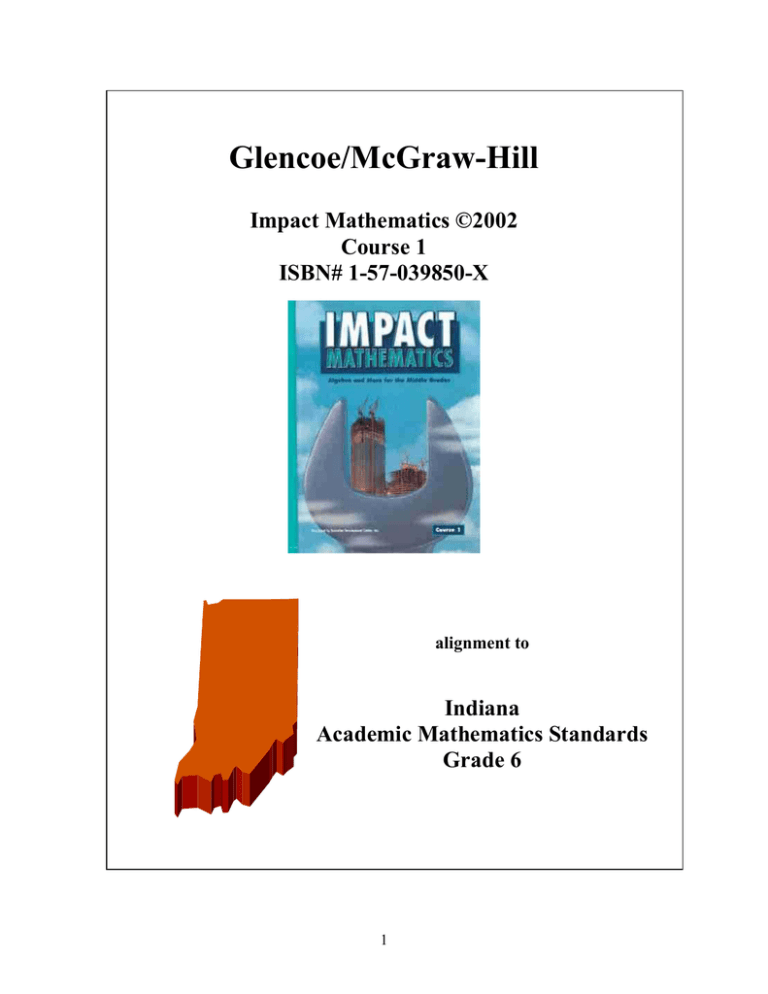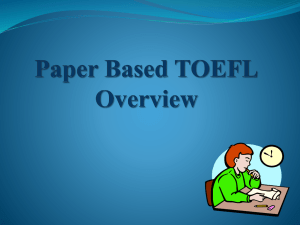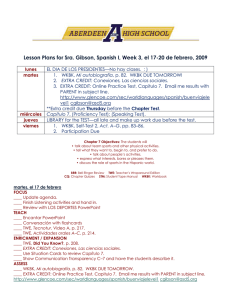Impact Mathematics
advertisement

Glencoe/McGraw-Hill Impact Mathematics ©2002 Course 1 ISBN# 1-57-039850-X alignment to Indiana Academic Mathematics Standards Grade 6 1 GLENCOE/MCGRAW-HILL IMPACT MATHEMATICS ©2003 COURSE 1 ALIGNMENT TO INDIANA ACADEMIC MATHEMATICS STANDARDS FOR GRADE 6 OBJECTIVES PAGE REFERENCES Number Sense Students compare and order positive and negative integers*, decimals, fractions, and mixed numbers. They find multiples* and factors*. PE: 143–145, 146–147, 148–151 6.1.1 Understand and apply the basic concept of negative numbers (e.g., on a TWE: T143–T145, T146–T147, T148–T151 number line, in counting, in temperature, in “owing”). 6.1.2 6.1.3 6.1.4 6.1.5 Interpret the absolute value of a number as the distance from zero on a number line, and find the absolute value of real numbers. PE: 143, 144 TWE: T143, T144 Note: Covered in Impact Course 2, Chapter 4. PE: 97–98, 101, 102–103, 108, 113–117, 120–122, 129, 142, 145, 147 Compare and represent on a number line positive and negative integers, fractions, decimals (to hundredths), and mixed numbers. TWE: T97–T98, T101, T102–T103, T108, T113–T117, T120–T122, T129, T142, T145, T147 Convert between any two representations of numbers (fractions, decimals, and percents) without the use of a calculator. PE: 131–134, 135–136, 137–141, 236– 239, 240–247 TWE: T131–T134, T135–T136, T137–T141, T236–T239, T240–T247 Recognize decimal equivalents for commonly used fractions without the use of a calculator. PE: 128–131, 131–134, 135–136, 137– 141, 150–151 TWE: T128–T131, T131–T134, T135–T136, T137–T141, T150–T151 1 GLENCOE/MCGRAW-HILL IMPACT MATHEMATICS ©2003 COURSE 1 ALIGNMENT TO INDIANA ACADEMIC MATHEMATICS STANDARDS FOR GRADE 6 6.1.6 6.1.7 OBJECTIVES Use models to represent ratios. PE: Find the least common multiple* and the greatest common factor* of whole numbers. Use them to solve problems with fractions (e.g., to find a common denominator to add two fractions or to find the reduced form for a fraction). PAGE REFERENCES 175–177, 602–603, 605–607, 608– 612, 613–614, 615–619, 620–630, 631–637, 638–645, 646–655 TWE: T175–T177, T602–T603, T605–T607, T608–T612, T613–T614, T615–T619, T620–T630, T631–T637, T638–T645, T646–T655 PE: 82–84, 85–87, 90–95, 102, 148, 150– 151, 157–160, 166–171 TWE: T82–T84, T85–T87, T90–T95, T102, T148, T150–T151, T157–T160, T166–T171 Computation Students solve problems involving addition, subtraction, multiplication, and division of integers. They solve problems involving fractions, decimals, ratios, proportions, and percentages. 6.2.1 Add and subtract positive and negative PE: 142, 145–147, 150 integers. TWE: T142, T145–T147, T150 6.2.2 Multiply and divide positive and negative integers. 6.2.3 Multiply and divide decimals. Note: Covered in Impact Course 2, Chapter 4 and Quick Review Math Handbook, Book 1, p. 89, 91. Note: Covered in Impact Course 2, Chapter 4 and Quick Review Math Handbook, Book 1, p. 90, 91, 93. PE: 198–200, 201–203, 204–206, 207– 210, 211–212, 213–220, 222–223 TWE: 2 T198–T200, T201–T203, T204–T206, T207–T210, T211–T212, T213–T220, T222–T223 GLENCOE/MCGRAW-HILL IMPACT MATHEMATICS ©2003 COURSE 1 ALIGNMENT TO INDIANA ACADEMIC MATHEMATICS STANDARDS FOR GRADE 6 6.2.4 6.2.5 6.2.6 6.2.7 OBJECTIVES Explain how to multiply and divide positive fractions and perform the calculations. PE: PAGE REFERENCES 172–175, 176–177, 178–181, 182– 184, 185–188, 189–197, 201–203 TWE: T172–T175, T176–T177, T178–T181, T182–T184, T185–T188, T189–T197, T201–T203 Solve problems involving addition, subtraction, multiplication, and division of positive fractions and explain why a particular operation was used for a given situation. PE: 154–156, 157–160, 161–163, 166– 171, 172–175, 176–177, 178–181, 185–188, 182–184, 189–197, 201–203 TWE: T154–T156, T157–T160, T161–T163, T166–T171, T172–T175, T176–T177, T178–T181, T185–T188, T182–T184, T189–T197, T201–T203 Interpret and use ratios to show the relative sizes of two quantities. Use the notations: a/b, a to b, a:b. PE: 175–177, 602–603, 605–607, 608– 612, 613–614, 615–619, 620–630, 631–637, 638–645, 646–655 TWE: T175–T177, T602–T603, T605–T607, T608–T612, T613–T614, T615–T619, T620–T630, T631–T637, T638–T645, T646–T655 PE: 175–177, 602–603, 605–607, 608– 612, 613–614, 615–619, 620–630, 631–637, 638–645, 646–655 TWE: T175–T177, T602–T603, T605–T607, T608–T612, T613–T614, T615–T619, T620–T630, T631–T637, T638–T645, T646–T655 Understand proportions and use them to solve problems. 3 GLENCOE/MCGRAW-HILL IMPACT MATHEMATICS ©2003 COURSE 1 ALIGNMENT TO INDIANA ACADEMIC MATHEMATICS STANDARDS FOR GRADE 6 6.2.8 6.2.9 OBJECTIVES Calculate given percentages of quantities and solve problems involving discounts at sales, interest earned, and tips. PE: Use estimation to decide whether answers are reasonable in decimal problems. 6.2.10 Use mental arithmetic to add or subtract simple fractions and decimals. PAGE REFERENCES 224–225, 226–239, 240–247, 248– 255, 256–259, 260–267, 270–272, 273–275 TWE: T224–T225, T226–T239, T240–T247, T248–T255, T256–T259, T260–T267, T270–T272, T273–T275 PE: 199-201, 204–206, 208–210, 213, 215 TWE: T199-T201, T204–T206, T208–T210 PE: 154–156, 157–160, 161–163, 166–171 TWE: T154–T156, T157–T160, T161–T163, T166–T171 Algebra and Functions They evaluate algebraic expressions, solve simple linear equations, and graph and interpret their results. They investigate geometric relationships and describe them algebraically. PE: 556–557, 558–562, 565–569, 570– 6.3.1 Write and solve one-step linear 578, 579–585, 586–593, 594–598, equations and inequalities in one 599–601 variable and check the answers. 6.3.2 6.3.3 Write and use formulas with up to three variables to solve problems. Interpret and evaluate mathematical expressions that use grouping symbols such as parentheses. 4 TWE: T556–T557, T558–T562, T565–T569, T570–T578, T579–T585, T586–T593, T594–T598, T599–T601 PE: 431–432, 434, 484, 488, 497, 517, 519, 560–562, 594–598 TWE: T431–T432, T434, T484, T488, T497, T517, T519, T560–T562, T594–T598 PE: 19–22, 25, 72, 412, 501, 558, 559, 565 TWE: T19–T22, T25, T72, T412, T501, T558, T559, T565 GLENCOE/MCGRAW-HILL IMPACT MATHEMATICS ©2003 COURSE 1 ALIGNMENT TO INDIANA ACADEMIC MATHEMATICS STANDARDS FOR GRADE 6 6.3.4 6.3.5 6.3.6 6.3.7 6.3.8 OBJECTIVES Use parentheses to indicate which operation to perform first when writing expressions containing more than two terms and different operations. PE: PAGE REFERENCES 19–22, 25, 71, 72, 412, 501 TWE: T19–T22, T25, T71, T72, T412, T501 PE: 278–279, 476, 484, 486, 488, 493, 497, 508–513, 517, 519, 523, 525– 527, 538, 551–555 TWE: T278–T279, T476, T484, T486, T488, T493, T497, T508–T513, T517, T519, T523, T525–T527, T538, T551–T555 Apply the correct order of operations and the properties of real numbers (e.g., identity, inverse, commutative*, associative*, and distributive* properties) to evaluate numerical expressions. Justify each step in the process. PE: 19–22, 25, 71, 412, 501, 504, 505, 572 TWE: T19–T22, T25, T71, T412, T501, T504, T505, T572 Identify and graph ordered pairs in the four quadrants of the coordinate plane. PE: 278–282, 283–286, 296, 302–305, 306–310, 311–315, 317–323, 324– 326, 327–339 TWE: T278–T282, T283–T286, T296, T302–T305, T306–T310, T311–T315, T317–T323, T324–T326, T327–T339 PE: 278–282, 282–286, 302–305, 558– 559, 560–562 TWE: T278–T282, TT282–T286, TT302– T305, TT558–T559, TT560–T562 Use variables in expressions describing geometric quantities. Solve problems involving linear functions with integer* values. Write the equation and graph the resulting ordered pairs of integers on a grid. 5 GLENCOE/MCGRAW-HILL IMPACT MATHEMATICS ©2003 COURSE 1 ALIGNMENT TO INDIANA ACADEMIC MATHEMATICS STANDARDS FOR GRADE 6 6.3.9 OBJECTIVES Investigate how a change in one variable relates to a change in a second variable. PE: TWE: PAGE REFERENCES 278–279, 410–414, 415–418, 419– 421, 422–429, 560–562, 565–569 T278–T279, T410–T414, T415–T418, T419–T421, T422–T429, T560–T562, T565–T569 Geometry Students identify, describe, and classify the properties of plane and solid geometric shapes and the relationships between them. 46–49, 466–471, 472–476, 477–481 6.4.1 Identify and draw vertical*, adjacent*, PE: complementary*, and supplementary* TWE: T46–T49, T466–T471, T472–T476, angles and describe these angle T477–T481 relationships. 6.4.2 6.4.3 6.4.4 6.4.5 Use the properties of complementary, supplementary, and vertical angles to solve problems involving an unknown angle. Justify solutions. PE: 46–49, 466–471, 472–476, 477–481 TWE: T46–T49, T466–T471, T472–T476, T477–T481 Draw quadrilaterals* and triangles from given information about them. PE: 14, 43, 54–59, 61, 62, 67, 68, 175, 264, 334, 484, 494–498, 518–521, 546, 553, 532 TWE: T14, T43, T54–T59, T61, T62, T67, T68, T175, T264, T334, T484, T494– T498, T518–T521, T546, T553, T532 Understand that the sum of the interior angles of any triangle is 180º and that the sum of the interior angles of any quadrilateral is 360º. Use this information to solve problems. PE: 47–49, 466–471, 473–476, 477–481, 518–521 TWE: T47–T49, T466–T471, T473–T476, T477–T481, T518–T521 Identify and draw two-dimensional shapes that are similar*. Note: Covered in Impact Course 2, Chapter 7 and Chapter 8. 6 GLENCOE/MCGRAW-HILL IMPACT MATHEMATICS ©2003 COURSE 1 ALIGNMENT TO INDIANA ACADEMIC MATHEMATICS STANDARDS FOR GRADE 6 6.4.6 6.4.7 OBJECTIVES Draw the translation (slide) and reflection (flip) of shapes. PAGE REFERENCES Note: Covered in Impact Course 3, Chapter 5 and Quick Review Math Handbook, Book 1, pp. 316, 318-319. PE: 58–60, 590 Visualize and draw two-dimensional views of three-dimensional objects made from rectangular solids. TWE: T58–T60, T590 Note: Covered in Impact Course 2, Chapter 2. Measurement Students deepen their understanding of the measurement of plane and solid shapes and use this understanding to solve problems. They calculate with temperature and money, and choose appropriate units of measure in other areas. PE: 17–18, 145, 210, 295, 467–476, 477– 6.5.1 Select and apply appropriate standard 481, 486–489, 490–494, 495–497, units and tools to measure length, area, 498–500, 501–503, 508–512, 515– volume, weight, time, temperature, and 517, 518–521, 522–524, 525–527, the size of angles. 528–535, 536–539, 540–543, 597 TWE: 6.5.2 6.5.3 PE: Understand and use larger units for measuring length by comparing miles to yards and kilometers to meters. T17–T18, T145, T210, T295, T467– T476, T477–T481, T486–T489, T490–T494, T495–T497, T498–T500, T501–T503, T508–T512, T515–T517, T518–T521, T522–T524, T525–T527, T528–T535, T536–T539, T540–T543, T597 117-119, 211, 482–486 TWE: T117-T119, T211, T482–486 Note: Covered in Quick Review Math Handbook, Book 1, pp. 352-357, 359. PE: 495–497, 508–511, 544–550 Understand and use larger units for measuring area by comparing acres and square miles to square yards and square kilometers to square meters. TWE: 7 T495–T497, T508–T511, T544–T550 GLENCOE/MCGRAW-HILL IMPACT MATHEMATICS ©2003 COURSE 1 ALIGNMENT TO INDIANA ACADEMIC MATHEMATICS STANDARDS FOR GRADE 6 6.5.4 OBJECTIVES Understand the concept of the constant π as the ratio of the circumference to the diameter of a circle. Develop and use the formulas for the circumference and area of a circle. PE: PAGE REFERENCES 486–489, 490–494, 522–524, 525– 527, 528–535 TWE: T486–T489, T490–T494, T522–T524, T525–T527, T528–T535 Know common estimates of π (3.14, 22⁄7) and use these values to estimate and calculate the circumference and the area of circles. Compare with actual measurements. PE: 486–489, 490–494, 522–524, 525– 527, 528–535 TWE: T486–T489, T490–T494, T522–T524, T525–T527, T528–T535 6.5.6 Understand the concept of significant figures and round answers to an appropriate number of significant figures. Note: Covered in Quick Review Math Handbook, Book 1, pp. 354-355. 6.5.7 Construct a cube and rectangular box from two-dimensional patterns and use these patterns to compute the surface area of these objects. PE: 6.5.5 6.5.8 6.5.9 58–60, 534, 590 TWE: T58–T60, T534, T590 Note: Covered in Quick Review Math Handbook, Book 1, p. 330. PE: 534, 590, 597 Use strategies to find the surface area and volume of right prisms* and cylinders using appropriate units. TWE: T534, T590, T597 Note: Covered in Impact 2 Course 2, Chapter 2 and Quick Review Math Handbook, Book 1, pp. 330-339. PE: 17–18, 448 Use a formula to convert temperatures between Celsius and Fahrenheit. TWE: T17–T18, T448 Note: Covered in Course 2, Chapter 1. 8 GLENCOE/MCGRAW-HILL IMPACT MATHEMATICS ©2003 COURSE 1 ALIGNMENT TO INDIANA ACADEMIC MATHEMATICS STANDARDS FOR GRADE 6 OBJECTIVES 6.5.10 Add, subtract, multiply, and divide with money in decimal notation. PE: TWE: PAGE REFERENCES 199, 205, 206, 211, 213, 215, 216 T199, T205, T206, T211, T213, T215, T216 Data Analysis and Probability Students compute and analyze statistical measures for data sets. They determine theoretical and experimental probabilities and use them to make predictions about events. PE: 276–291, 292–299, 300–305, 306– 6.6.1 Organize and display single-variable 310, 311–315, 346–349, 350–352, data in appropriate graphs and stem353–361, 365, 366–369, 402–407 and-leaf plots*, and explain which types of graphs are appropriate for TWE: T276–T291, T292–T299, T300–T305, various data sets. T306–T310, T311–T315, T346–T349, T350–T352, T353–T361, T365, T366–T369, T402–T407 6.6.2 6.6.3 Make frequency tables for numerical data, grouping the data in different ways to investigate how different groupings describe the data. Understand and find relative and cumulative frequency for a data set. Use histograms of the data and of the relative frequency distribution, and a broken line graph for cumulative frequency, to interpret the data. PE: 289–290, 342–345, 346–349, 350– 352, 353–361, 365, 394–395, 402, 404 TWE: T289–T290, T342–T345, T346–T349, T350–T352, T353–T361, T365, T394–T395, T402, T404 Compare the mean*, median*, and mode* for a set of data and explain which measure is most appropriate in a given context. PE: 362–365, 370–372, 373–376, 379, 380–389, 398, 402–407 TWE: T362–T365, T370–T372, T373–T376, T379, T380–T389, T398, T402–T407 9 GLENCOE/MCGRAW-HILL IMPACT MATHEMATICS ©2003 COURSE 1 ALIGNMENT TO INDIANA ACADEMIC MATHEMATICS STANDARDS FOR GRADE 6 6.6.4 6.6.5 6.6.6 OBJECTIVES Show all possible outcomes for compound events in an organized way and find the theoretical probability of each outcome. Use data to estimate the probability of future events. Understand and represent probabilities as ratios, measures of relative frequency, decimals between 0 and 1, and percentages between 0 and 100 and verify that the probabilities computed are reasonable. PE: PAGE REFERENCES 608–610, 611, 612, 613–614, 615– 619, 620–630, 631–637, 638–645, 646–651, 652–655 TWE: T608–T610, T611, T612, T613–T614, T615–T619, T620–T630, T631–T637, T638–T645, T646–T651, T652–T655 PE: 608–610, 611, 612, 613–614, 615– 619, 620–630, 631–637, 638–645, 646–651, 652–655 TWE: T608–T610, T611, T612, T613–T614, T615–T619, T620–T630, T631–T637, T638–T645, T646–T651, T652–T655 PE: 608–610, 611, 612, 613–614, 615– 619, 620–630, 631–637, 638–645, 646–651, 652–655 TWE: T608–T610, T611, T612, T613–T614, T615–T619, T620–T630, T631–T637, T638–T645, T646–T651, T652–T655 Problem Solving Students make decisions about how to approach problems and communicate their ideas. This objective is addressed throughout. See, for 6.7.1 Analyze problems by identifying example: relationships, telling relevant from irrelevant information, identifying PE: 69–73, 148–151, 221–222, 273–275, missing information, sequencing and 336–339, 402–407, 460–463, 551– prioritizing information, and observing 555, 576–578, 589–591, 592–593, patterns. 594–598, 652–655 TWE: 10 T69–T73, TT148–T151, T221–T222, T273–T275, T336–T339, T402–T407, T460–T463, T551–T555, T576–T578, T589–T591, T592–T593, T594–T598, T652–T655 GLENCOE/MCGRAW-HILL IMPACT MATHEMATICS ©2003 COURSE 1 ALIGNMENT TO INDIANA ACADEMIC MATHEMATICS STANDARDS FOR GRADE 6 6.7.2 6.7.3 OBJECTIVES Make and justify mathematical conjectures based on a general description of a mathematical question or problem. Decide when and how to break a problem into simpler parts. PAGE REFERENCES This objective is addressed throughout. See, for example: PE: 4-13, 14-27, 28-41, 69–73, 148–151, 221–222, 273–275, 336–339, 402– 407, 460–463, 551–555, 576–578, 589–591, 592–593, 594–598, 652–655 TWE: T4-T13, T14-T27, T28-T41, T69– T73, T148–T151, T221–T222, T273– T275, T336–T339, T402–T407, T460–T463, T551–T555, T576–T578, T589–T591, T592–T593, T594–T598, T652–T655 PE: 77–79, 80–81, 82–84, 90–95, 166– 171, 189–197, 270–272, 586–588, 589–591, 592–593, 594–598 TWE: T77–T79, T80–T81, T82–T84, T90– T95, T166–T171, T189–T197, T270– T272, T586–T588, T589–T591, T592–T593, T594–T598 Students use strategies, skills, and concepts in finding and communicating solutions to problems. This objective is addressed throughout. See, for 6.7.4 Apply strategies and results from example: simpler problems to solve more complex problems. PE: 10–13, 166–171, 189–197, 213–220, 240–247, 256–259, 270–272, 273– 275, 565–569, 579–585, 594–598, 615–619, 631–637, 646–651, 652–655 TWE: 11 T10–T13, T166–T171, T189–T197, T213–T220, T240–T247, T256–T259, T270–T272, T273–T275, T565–T569, T579–T585, T594–T598, T615–T619, T631–T637, T646–T651, T652–T655 GLENCOE/MCGRAW-HILL IMPACT MATHEMATICS ©2003 COURSE 1 ALIGNMENT TO INDIANA ACADEMIC MATHEMATICS STANDARDS FOR GRADE 6 6.7.5 6.7.6 6.7.7 6.7.8 OBJECTIVES Express solutions clearly and logically by using the appropriate mathematical terms and notation. Support solutions with evidence in both verbal and symbolic work. Recognize the relative advantages of exact and approximate solutions to problems and give answers to a specified degree of accuracy. Select and apply appropriate methods for estimating results of rationalnumber computations. Use graphing to estimate solutions and check the estimates with analytic approaches. PAGE REFERENCES This objective is addressed throughout. See, for example: PE: 8, 10, 20, 22, 186, 207, 413, 414, 419, 436–438, 439, 443–449, 559, 604– 614, 615–619 TWE: T8, T10, T20, T22, T186, T207, T413, T414, T419, T436–T438, T439, T443–T449, T559, T604–T614, T615–T619 PE: 104–105, 106–111, 128–131, 137– 141, 589–591, 594–601, 606, 607, 608–612, 652 TWE: T104–T105, T106–T111, T128–T131, T137–T141, T589–T591, T594–T601, T606, T607, T608–T612, T652 PE: 104–105, 106–111, 128–131, 137– 141, 589–591, 592–593, 594–601 TWE: T104–T105, T106–T111, T128–T131, T137–T141, T589–T591, T592–T593, T594–T601 PE: 104–105, 106–111, 128–131, 317– 318, 319, 320–323, 324–326, 327– 339, 594–601 TWE: T104–T105, T106–T111, T128–T131, T317–T318, T319, T320–T323, T324–T326, T327–T339, T594–T601 12 GLENCOE/MCGRAW-HILL IMPACT MATHEMATICS ©2003 COURSE 1 ALIGNMENT TO INDIANA ACADEMIC MATHEMATICS STANDARDS FOR GRADE 6 6.7.9 OBJECTIVES Make precise calculations and check the validity of the results in the context of the problem. PE: TWE: PAGE REFERENCES 69–73, 148–151, 221–222, 273–275, 336–339, 402–407, 460–463, 551– 555, 576–578, 586–588, 589–591, 592–593, 594–601, 652–655 T69–T73, T148–T151, T221–T222, T273–T275, T336–T339, T402–T407, T460–T463, T551–T555, T576–T578, T586–T588, T589–T591, T592–T593, T594–T601, T652–T655 Students determine when a solution is complete and reasonable and move beyond a particular problem by generalizing to other situations. This objective is addressed throughout. See, for 6.7.10 Decide whether a solution is example: reasonable in the context of the original situation. PE: 199-201, 204-206, 208-210, 213, 215, 211, 222, 586–588, 589–591, 592– 593, 594–601 TWE: 6.7.11 Note the method of finding the solution and show a conceptual understanding of the method by solving similar problems. T199-T201, T204-T206, T208-T210, T211, T222, T586–T588, T589–T591, T592–T593, T594–T601 This objective is addressed throughout. See, for example: PE: 69–73, 148–151, 221–222, 273–275, 336–339, 402–407, 460–463, 551– 555, 576–578, 589–591, 592–593, 594–598, 652–655 TWE: T69–T73, T148–T151, T221–T222, T273–T275, T336–T339, T402–T407, T460–T463, T551–T555, T576–T578, T589–T591, T592–T593, T594–T598, T652–T655 13 GLENCOE/McGraw-Hill South Central Region 6510 Jimmy Carter Boulevard Norcross, GA 30071 770/613–0281 800/731–2365





